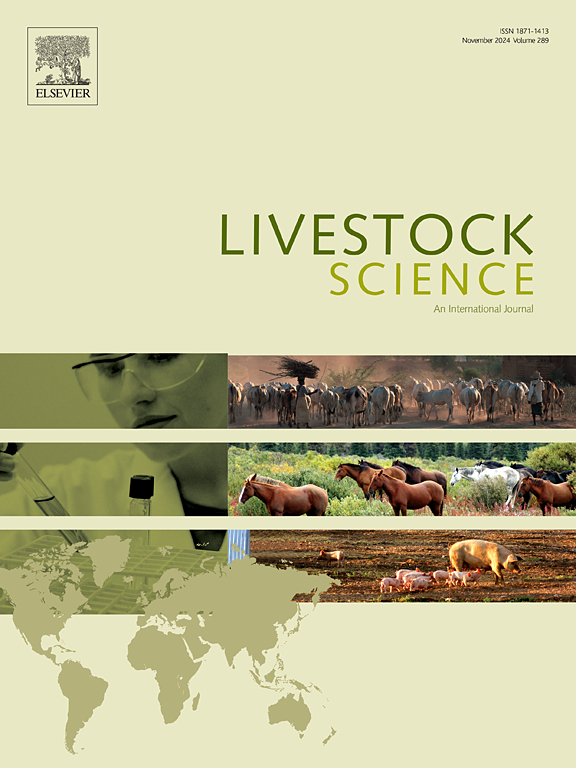育肥期饲粮中性洗涤纤维含量对南非美利奴羔羊生产性能、肉脂肪酸组成、嫩度和稳定性的影响
IF 1.9
3区 农林科学
Q2 AGRICULTURE, DAIRY & ANIMAL SCIENCE
引用次数: 0
摘要
本试验旨在研究降低育肥期南非美利奴羊羔羊饲粮中中性洗涤纤维(NDF)含量对肉质脂肪酸(FA)组成、嫩度和稳定性的影响。54只4月龄羔羊(29.14±1.66 kg);平均±SD)随机分配到5个饲粮处理中,每个处理n = 10只羊(每个重复n = 1只羊),最终形成随机试验设计。羊羔被单独饲养在围栏内(1.404平方米),围栏上有高架的木条地板。配制了氮含量相似的5种饲粮处理,其NDF含量不同。分别为379 (CON)、314 (NDF1)、251 (NDF2)、192 (NDF3)和143 (NDF4) g NDF/kg干物质(DM)。生产研究进行了61天。采用固定疗效的LSMEANS/DIFF方法分析均数,事后采用Tukey’s HSD检验。采用PROC REG进行回归分析。所有的估计都在5%的概率水平上进行了测试。降低饲粮NDF含量线性降低了南非羊美利奴肌肉组织硬脂酸和α-亚麻酸含量,线性增加了棕榈酸、棕榈油酸、异丙酸、亚油酸、总ω -6 (n-6)和n-6: ω -3 (n-3)比值以及相同组织的∆9去饱和酶指数。饮食治疗对皮下脂质组织的影响更广泛,呈线性增加(P <;0.0001)油酸、异丙酸、亚油酸和花生四烯酸含量,∆9去饱和酶指数,以及总单不饱和脂肪酸(MUFA)、多不饱和脂肪酸(PUFA)、不饱和脂肪酸(UFA)、n-6、n-6:n-3和PUFA:SFA比值。脂肪组织脂质含量、硬脂酸和总饱和脂肪酸(SFA)含量以及动脉粥样硬化指数呈线性下降(P <;0.0001),降低了NDF含量。处理不影响羔羊肌肉和脂肪组织共轭亚油酸(CLA: C18:2c9,t11)含量。降低饲粮NDF含量线性降低了第4天和第8天贮藏样品的羔羊最长肌组织亮度(L*)、新鲜(第0天和第8天)样品的黄度(b*)和色相角,以及第8天样品的色度。相反,随着饲粮NDF含量的降低,第8天储存肌肉组织的红度(a*)呈线性增加。饮食处理对最长肌压痛和氧化稳定性无影响。降低育肥期南非美利奴羔羊NDF含量的优势似乎有利于影响皮下脂肪组织的PUFA:SFA比率,但对脂肪和肌肉组织的n-6:n-3比率不利,而总n-3含量则不受影响。如果将n-3含量高的脂质源添加到南非美利奴羊的低ndf育肥期日粮中,可能会增加其在肉中的含量。本文章由计算机程序翻译,如有差异,请以英文原文为准。
The effect of finishing diet neutral detergent fibre content on South African Mutton Merino lamb performance, meat fatty acid composition, tenderness and stability
A trial was conducted studying the effect of reducing neutral detergent fibre (NDF) content in the diet of finishing South African Mutton Merino wether lambs on meat fatty acid (FA) composition, tenderness and stability. Fifty four-month-old lambs (29.14±1.66 kg; mean±SD) were assigned at random to the five dietary treatments with n = 10 lambs per treatment (n = 1 lamb per replicate), culminating into a randomised trial design. The lambs were housed individually in pens (1.404 m²) on elevated wooden slatted floors. Five dietary treatments similar in nitrogen content were formulated differing in respect to the NDF content thereof. Treatments were described as containing 379 (CON), 314 (NDF1), 251 (NDF2), 192 (NDF3) and 143 (NDF4) gram NDF/kg dry matter (DM), respectively. The production study was conducted over a period of 61 days. Means were analysed using the LSMEANS/DIFF with treatment as fixed effect, and post hoc using Tukey's HSD test. Regression analyses was conducted by PROC REG. All estimates were tested at the 5 % probability level. A reducing dietary NDF content linearly decreased the stearic and α-linolenic acid content of South African Mutton Merino muscle tissue, but linearly increased the palmitic, palmitoleic, vaccenic, linoleic acid, total omega-6 (n-6) and n-6:omega-3 (n-3) ratio, as well as ∆9 desaturase index of the same tissue. Subcutaneous lipid tissue was more extensively affected by dietary treatment and linearly increased (P < 0.0001) oleic, vaccenic, linoleic and arachidonic acid content, ∆9 desaturase index, as well as total mono-unsaturated fatty acid (MUFA), poly-unsaturated fatty acid (PUFA), unsaturated fatty acid (UFA), n-6, n-6:n-3 and PUFA:SFA ratios following decreased dietary NDF content. In contrast, adipose tissue lipid content, stearic acid and total saturated fatty acid (SFA) content, as well as atherogenicity index linearly decreased (P < 0.0001) following a decreased dietary NDF content. Treatment did not affect the conjugated linoleic acid (CLA: C18:2c9,t11) content of lamb muscle or adipose tissue. Reducing dietary NDF content linearly decreased lamb longissimus muscle tissue lightness (L*) of day-4 and day-8 storage samples, yellowness (b*) and hue angle of the fresh (day-0) and day-8 samples, as well as chroma of the day-8 sample. In contrast, the redness (a*) of the day-8 storage muscle tissue increased linearly following a decrease in dietary NDF content. Dietary treatment had no effect on longissimus muscle tenderness nor oxidative stability. The advantage of reducing the NDF contend of a finishing diet for South African Mutton Merino lambs seems to favourably affect the PUFA:SFA ratio of subcutaneous lipid tissue, but negatively affect the n-6:n-3 ratio of both lipid and muscle tissue, whereas the total n-3 content was left unaffected. A lipid source high in n-3 would be of benefit if added to a low-NDF finishing diet fed to South African Mutton Merino wethers to possibly increase its content within their meat.
求助全文
通过发布文献求助,成功后即可免费获取论文全文。
去求助
来源期刊

Livestock Science
农林科学-奶制品与动物科学
CiteScore
4.30
自引率
5.60%
发文量
237
审稿时长
3 months
期刊介绍:
Livestock Science promotes the sound development of the livestock sector by publishing original, peer-reviewed research and review articles covering all aspects of this broad field. The journal welcomes submissions on the avant-garde areas of animal genetics, breeding, growth, reproduction, nutrition, physiology, and behaviour in addition to genetic resources, welfare, ethics, health, management and production systems. The high-quality content of this journal reflects the truly international nature of this broad area of research.
 求助内容:
求助内容: 应助结果提醒方式:
应助结果提醒方式:


